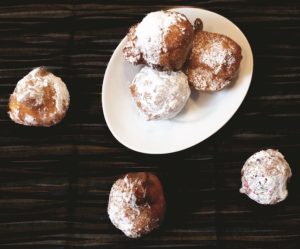Mardi Gras, a.k.a. Fat Tuesday, is next week — the last hurrah before the 40 days of fasting and self-reflection of Lent begin, for those who observe it. Besides prompting parades, parties, and great music, Mardi Gras includes permission — some would say a requirement — to indulge in rich and fatty foods.
The idea is to use up the butter, oil, and eggs you have in the kitchen before “I gave it up for Lent” kicks in. Which leads people around the globe to make donuts. The Portuguese celebrate the end of carnival with malassadas, an egg-rich dough, crisp-fried and rolled in cinnamon sugar; in Poland, people fry up paczki, plush pillows of fruit-filled donuts; and, of course, New Orleanians fry and dust their signature beignets in a blizzard of powdered sugar.

Donuts are part of my Cape Cod food roots. I spent my childhood summers in Chatham with my very proper grandmother. Ganny had a perfect pouf of frosty hair, wore pince-nez, and chain-smoked Kent cigarettes in an ivory holder. She was old school. Around Ganny, I absolutely had to mind my p’s and q’s. But she would wink and nod to the kitchen, where there was always a waxed-paper bag of hand-cut sugar-coated donut holes from her favorite bakery just for me. Donut holes are my Proustian prompt.
Donuts are so New England. Local lore credits their ring design to Yankee ingenuity — an innovation that allowed sailors to stow their cakes on the spokes of a ship’s wheel. In Moby-Dick, Herman Melville has the crew frying up nuts of dough in the Pequod’s rolling try-pots. Vermonters have the odd but wholesome practice of serving cake donuts and sour pickles alongside bowls of snow drizzled with freshly tapped maple syrup.
When I stumbled on Sally Levitt Steinberg’s The Donut Book it fixed my love of all things donut. As the self-described Donut Princess — her grandfather invented the first mechanized donut machine for his Times Square Mayflower Donut Shop and made a fortune, and her fabulous collection of donut ephemera is now at the Smithsonian — she unpacks the glory of this everyman breakfast item.
Ever wonder why American World War I soldiers were called Doughboys? From all the donuts they ate fried up by the women who were allowed on the battlefields as Salvation Army volunteers. Steinberg includes the proper dunking etiquette, exemplified by Clark Cable in It Happened One Night. Need a cunning way to trap a bear? Try a sack of donuts. I failed college astronomy, but I am fascinated by the theory that the universe is a cosmic donut.
This “Optimist’s Creed” was printed on boxes of Mayflower donuts: “As you ramble on through life, brother,/ Whatever be your goal,/ Keep your eye upon the doughnut,/ And not upon the hole.”
But donut holes are exactly what I have my eye on when I want to fry up homemade donuts for Fat Tuesday. Most donuts are made from either a raised yeast dough or a denser cake style batter. These I leave to the pros. The French version I make, pets de nonne — translation: nun’s farts — are a variation on beignets.
About their name: the story goes that a young nun broke wind while cooking and to disguise the interruption she dropped a bit of batter into bubbling hot oil. After the dough puffed into a wondrous hollow orb, more were made. The sisters agreed they were heavenly.
Nun’s farts are fun to make and serve. Though sometimes, in honor of my Ganny, I use the more proper euphemism, les soupirs de nonne: nun’s sighs.
Pets de Nonne
Makes about 2 dozen
½ cup milk
¼ cup water
4 Tbsp. unsalted butter, diced
1 Tbsp. granulated sugar
¼ tsp. fine salt
¾ cup all-purpose flour
¼ tsp. baking powder
¾ tsp. vanilla extract
¼ tsp. freshly grated nutmeg or ground cinnamon
3 large eggs
Vegetable oil and shortening for frying
Confectioners’ sugar
- Heat the milk, water, butter, sugar, and salt in a saucepan over medium-high heat, stirring occasionally, until the butter melts and the mixture just starts to boil. Meanwhile, whisk the flour and baking powder together in a bowl.
- Slip the pan off the heat, dump in the flour mixture, and stir with a sturdy wooden spoon into a smooth paste. Return the pan to medium heat and continue stirring, turning and flattening the paste on the bottom of the pan with the spoon. Cook until it leaves a light film on the pan and a nice buttery sheen on your finger, about one minute.
- Transfer the paste to an electric mixer fitted with a paddle attachment and beat to cool slightly, about 30 seconds. If you don’t have a mixer, go old school and just continue beating with a wooden spoon. Add the vanilla and nutmeg.
- Crack the eggs into a measuring cup with a spout. While mixing the batter, pour in the first egg. The dough may resist the egg, but keep mixing. Once the egg is incorporated, pour in the next egg and mix again. Repeat with the third egg. Set the finished dough aside while you heat the oil.
- Pour the oil and a big spoonful of shortening into a deep medium saucepan. You need enough so it is about three inches deep. Heat the oil over medium-high heat to 340° on a deep-fry thermometer. Carefully drop 3 or 4 walnut-size spoonsful of dough (a scant tablespoon) into the oil. Take care not to overcrowd the pan. The first few may be imperfect. Don’t let the oil go over 350° or under 320°. This is the fun part: they balloon and bob and turn (mostly) on their own. Fry until golden, about 5 minutes.
- Remove with a slotted spoon to a paper towel-lined pan or platter. Dust generously with the confectioners’ sugar. Repeat with remaining batter. Serve warm.
